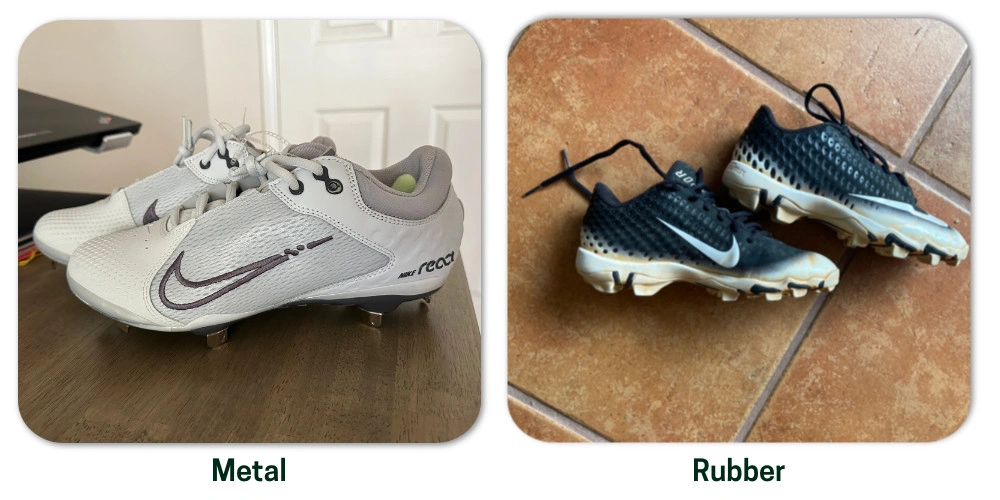Are You Wearing the Right Softball Cleats?
At age 14, I experienced a lot of new things.
After 9 years at my previous school, it was now time to move up to the high school.
That meant competitive slowpitch was no longer an option for me, so it was time to try something new with fastpitch softball.
Once I finally got a few practices under my belt, we got word of another new thing - metal cleats.
For the first time ever, the state high school league was going to allow fastpitch softball players to wear metal cleats.
For me, shoes were everything and I LOVED the look of my rubber cleats, so why did I have to change?
Now, most athletes make a seamless transition at the youth level, but if you’re unfamiliar with the differences between rubber and metal cleats, this article is for you.
Rubber vs. Metal Cleats
Let’s start with the basics - what’s the difference?
The distinction between the two lies in the make of the cleat or spike on the bottom of the shoe.
Rubber, or molded, cleats are made of a combination of plastic and rubber. They are praised for their durability and flexibility as you can wear them on all playing surfaces (more on this below).
Metal cleats are made up of a firm steel and carbon mixture. These are preferred by higher level athletes because of the improved traction and the ability to dig into the dirt or grass.
Rubber cleats are preferred at the youth level for 2 primary reasons:
-
Safety - Most leagues, coaches and parents agree that with athletes still in the developmental stages that a rubber cleat is a safer option.
-
Weight - Metal cleats are made of a heavier material, which means a heavier shoe for the athlete. Rubber is preferred for its lightweight feel.
Are There Rules Against Metal Cleats?
While metal cleats appear to be the logical option for a sport played primarily on dirt and grass, you need to be aware of two rules before purchase.
Metal cleats are NOT allowed at all age levels.
As previously mentioned, safety is a big concern when little bodies, fingers and toes are rolling around the ball field. For that reason, many states and associations do not permit the use of metal cleats until upper level youth and high school levels (i.e. in my home state, metal cleats are not permitted until 14U). It’s important you check with your local league and association to confirm the age requirement for metal cleats before purchase.
Metal cleats are NOT permitted on all surfaces.
Metal cleats provide excellent traction on dirt and grass, but they do that by ripping up those surfaces. Most artificial turf and rubber surfaces do not allow for the use of metal cleats because they can rip up and ruin them. This is less of a concern for youth athletes, but is something to be aware of at the high school and collegiate level.
Do You Need Both?
Both metal and rubber cleats have their place in the sport; however, many athletes and parents (the ones making the purchase) want to know if both are necessary.
If you or your athlete are in the sport long enough, you’ll likely have to invest in a pair of each throughout your playing career. That does NOT necessarily mean you’ll need to have 2 pairs of cleats at all times.
When budget is a concern, make a purchase based on what you’ll need most often. It’s important to note that metal cleats are often more expensive; however, these are more likely to have an option for an interchangeable rubber cleat for a 2-in-1 shoe.
Seeing as rubber cleats are required at most youth levels, you’ll need to invest in a quality pair of rubber cleats. These will carry your athlete through outdoor games and practices, and they can double as an indoor or turf practice shoe.
Once you enter the upper level youth, high school and collegiate level, your decision is best made on your most frequented playing surface. I recommend thinking about what is going to give you the most competitive option. Like most, you’ll be playing on dirt most often, so a metal cleat will provide the best traction, and a tennis shoe can be used for a turf or practice
Personally, my collegiate career featured a near 50/50 split in playing on turf versus dirt, so I wish I would have invested in a pair of rubber cleats for something better than tennis shoes on a turf surface.
Do Different Positions Require Different Cleats?
You know the differences between the 2 styles of cleats.
You know the requirements based on your age level.
You understand the requirements of your playing surface.
There’s just one more thing to consider before purchase - your position.
At age levels where you’re in and out of positions, this will matter little as you’re looking for a shoe with versatility. However; it’s important for pitchers and catchers to carefully weigh their options.
Some pitchers find the lack of traction in a rubber cleat to better support her pivot when compared to how a metal cleat digs into the dirt.
Similarly, many pitchers find the “stick” of the metal cleat improves stability and release in their stride foot.
Crazy as it may sound, I have seen pitchers sporting one of each cleat.
When it comes to catchers, recent years have shown more catchers reverting back to molded rubber cleats. Many catchers find the rubber cleats allow for quicker transitions out of a crouch and less pull on their ankles and knees.
On the other hand, the majority of catchers choose to stick with their metal cleats because they add more stability in their crouched receiving position.
What Should You Look for When Purchasing Cleats?
It’s time for the big decision!
What should you look for when shopping for cleats?
Once you’ve narrowed down your style of cleat, the purchase is really no different from that of a tennis shoe. Many of the big name tennis shoe companies are producing cleats (Nike, Addias, Reebok, Under Armor, Mizuno), so it’s likely you’ll go in with a brand preference.
No matter which type or brand of cleats you buy, there is an adjustment period. I recommend that you start wearing them in small practice increments to reduce your risk for blistering, aches and soreness. Limit intense cutting and pivoting until the shoe is more broken in.
Once they’re broken in, it’s time to lace ‘em up and play ball.

